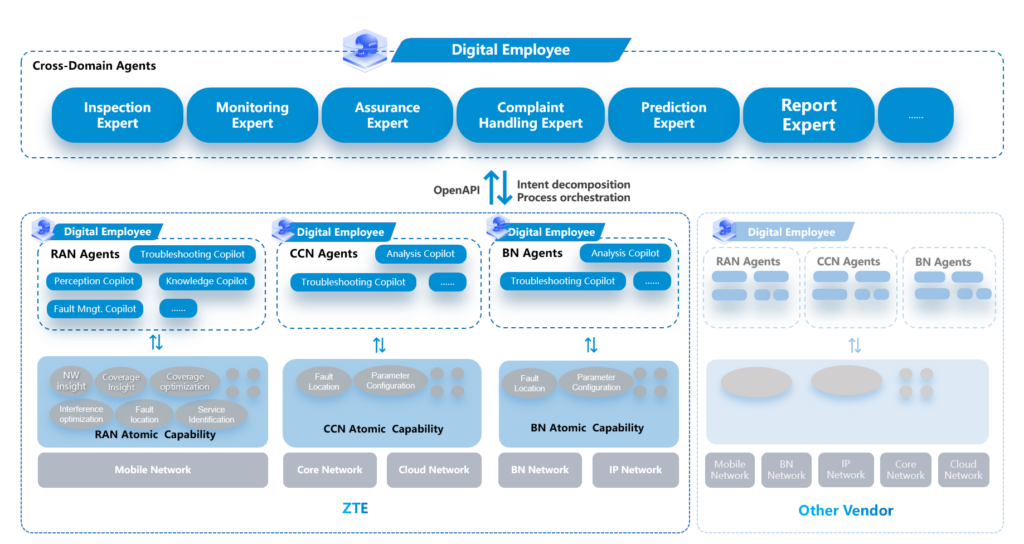Multi-agent collaboration solutions are systems where multiple AI agents work together within a network to accomplish complex tasks or solve intricate problems. These agents communicate, share data, and make collaborative decisions in real time, leveraging each agent’s strengths and specializations to improve efficiency, optimize performance, and enhance decision-making processes.
In the telecommunications field, multi-agent collaboration solutions can be used to manage and optimize network operations. For example, they enable intelligent automation of tasks like traffic management, predictive maintenance, and network troubleshooting by allowing various agents to analyze real-time data, predict potential issues, and implement corrective actions autonomously. This distributed approach is particularly useful for complex, large-scale networks, like those seen in 5G and 5G-Advanced (5G-A), where manual operations would be time-consuming and prone to error.
ZTE Corporation has recently unveiled the innovations of its mobile multi-agent collaboration solution with China Mobile during the China International Information and Communications Technology Exhibition (PTEXPO), which took place in China’s capital Beijing.
ZTE noted that its multi-agent collaboration solution introduces AI large models into the end-to-end operation and maintenance of mobile networks for the first time, yielding impressive performance and efficiency improvements across various locations in China, representing a significant leap forward in network digitalization and intelligence.
Through the extensive deployment and development of 5G, China Mobile has built the world’s largest mobile network. This expansion has led to increasingly complex network structures and diverse applications, demanding higher efficiency in network operations and maintenance. With the deep integration of 5G with AI+, the introduction of large models is revolutionizing the telecom industry.
The innovations of the mobile multi-agent collaboration solution are built upon the latest AI LLM (Large language Model) tailored for the telecom industry. The solution leverages the network’s native AI atomic capabilities, empowering the network operation and maintenance platform, and exploring a new paradigm for intelligent network management.
The mobile multi-agent collaboration solution integrates telecom knowledge, structured data and network capabilities, enabling accurate understanding and intelligent decision-making in complex operation and maintenance scenarios through multi-agent collaboration and orchestration. ZTE highlighted that the solution improves the network’s adaptive capabilities and self-service levels, promotes the synergy among various intelligent technologies and drives the overall advancement of network intelligence.

Since 2023, ZTE and China Mobile have actively promoted the AI multi-agent collaboration solution for network operation and maintenance, showcasing its effectiveness at major events across China, including the Wuzhen Internet Conference, concerts at the Hangzhou Olympic Sports Center, the Jin’an International Tennis Open, the Xi’an Great Tang All Day Mall, and various events in Beijing.
At a concert held at the Hangzhou Olympic Sports Center, the solution achieved a 30% reduction in manpower required for network performance assurance. Similarly, at the Xi’an Great Tang All Day Mall, it facilitated a 20% increase in network traffic while significantly enhancing user experience, explained ZTE.
ZTE also highlighted that the mobile multi-agent collaboration solution achieves complex intent understanding and precise service capabilities, through natural language interaction, enhancing deployment efficiency and improving autonomous decision-making with multi-agent collaboration.
The LLM-based multi-agent collaboration solution integrates the following types of self-decision-making capabilities:
-Complicated instruction understanding: The LLM enables agents to understand complicated instructions and communicate in natural languages. The AI agent can understand the request and perform related tasks, from booking a flight to selecting a hotel and arranging a ticket, and requires very little manual supervision.
-Planning and inference framework: The LLM develops the planning and inference capability, and enables agents to break down complex tasks into smaller and more manageable steps. This systematic approach is critical to effectively solving larger problems. These capabilities can be regarded as the “thinking chain” of the AI agent.
-Tool interaction enhancement: An important development of the LLM is the ability to interact with external tools and APIs. This capability enables the AI agent to execute tasks such as code execution, result interpretation, database interaction, network service interface, and digital workflow management.
– Memory and context management: The LLM also enhances memory and context management capabilities, which are critical for accurate understanding and intelligent decision-making in complex operation and maintenance scenarios.
“With the wide deployment and development of 5G, the world’s largest mobile network has been established, and the network architecture becomes more complicated and applications become more diversified. This requires higher efficiency of network operation and maintenance. The introduction of large-scale AI models is revolutionizing the telecom industry,” noted ZTE.
“By integrating telecom knowledge, structured data, and network capabilities, the multi-agent collaboration solution enables accurate understanding and intelligent decision-making through multi-agent collaboration and orchestration in complex operation and maintenance scenarios. This transformation changes from the traditional “man + tool” mode to the new self-orchestration intelligent service mode, improving the network adaptability and self-service level,” ZTE added.
The company also highlighted that the solution explores new business models and application scenarios, promotes the effective integration of 5G-A and AI, expands the 5G-A industry ecosystem, and enhances the overall industrial value.
To sum up, the multi-agent collaboration solution integrated with the LLM is highly adaptable in other telecom networks around the world. It can cope with the complexity of the network architecture, improve the efficiency of operation and maintenance, and explore new service modes and application scenarios.

